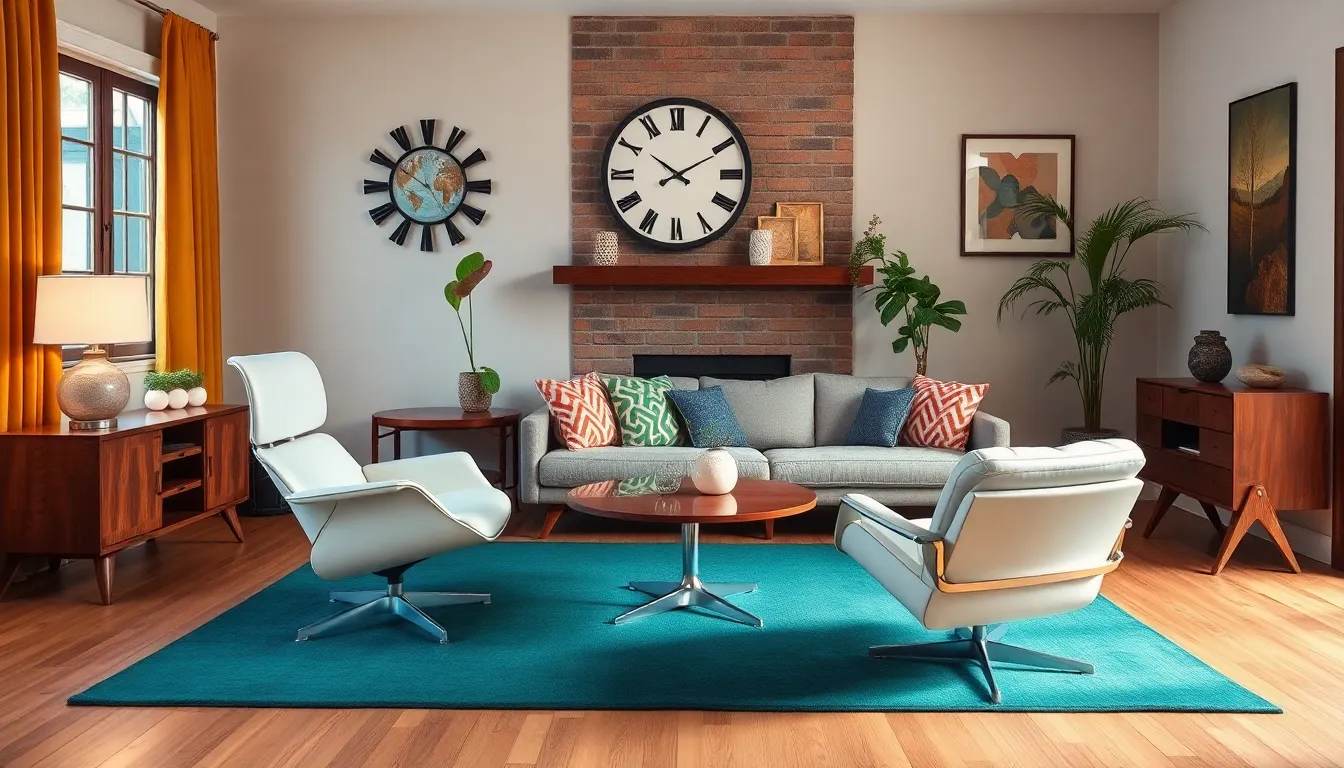Mid-century modern design isn’t just a style; it’s a lifestyle that screams sophistication while whispering comfort. Imagine sleek lines, organic shapes, and a dash of whimsy all wrapped up in a time capsule from the 1950s. This design movement took the world by storm, transforming homes into havens of chic minimalism. If you think your living room could use a little pizzazz, it might just be time to channel your inner Don Draper.
But it’s not all about looking good. Mid-century modern also embraces functionality, proving that style and practicality can indeed coexist. Whether it’s a funky Eames chair or a starburst clock, these pieces are more than furniture; they’re conversation starters. So, buckle up as we dive into the world of mid-century modern design, where every corner tells a story and every piece is a timeless treasure.
Table of Contents
ToggleOverview of Mid-Century Modern
Mid-century modern design emerged in the mid-20th century, becoming a pivotal movement in architecture and interior design. Characterized by clean lines and organic forms, this style reflects a strong connection between indoor and outdoor spaces. Influenced by technological advancements, designers embraced new materials like fiberglass, plywood, and metal.
The aesthetic emphasizes simplicity while maximizing functionality. Furniture pieces such as the Eames lounge chair and Barcelona chair combine comfort and style seamlessly. Iconic designs maintain a timeless appeal, serving as both practical items and artful accents.
Color palettes often consist of muted tones paired with pops of vibrant hues. Designers frequently incorporated bold colors to enhance visual interest and create inviting atmospheres. The strategic use of natural light and open floor plans fosters a spacious feel within homes.
The movement’s legacy extends beyond furniture and decor, influencing architecture significantly. Clean geometrical shapes define both residential and commercial buildings, epitomizing the mid-century modern approach. The integration of nature within residential spaces remains a fundamental characteristic, allowing owners to enjoy their surroundings.
Mid-century modern design encourages personalization and self-expression. Each piece tells a story and plays a role in the overall aesthetic, contributing to a cohesive environment. This unique style invites exploration of functional beauty, perfect for those seeking a sophisticated yet comfy lifestyle.
Key Characteristics of Mid-Century Modern Design

Mid-century modern design stands out for its functional aesthetics and versatility, featuring elements that evoke a sense of timelessness and style.
Furniture and Decor
Furniture in mid-century modern design emphasizes sleek, minimalist lines and organic forms. Iconic pieces like the Eames lounge chair or the Tulip table exemplify this style. They focus on comfortable functionality while making a statement. Decor often incorporates sculptural elements, displaying both artistry and practicality. Accessories like starburst clocks and geometric rugs further enhance visual appeal. Each piece is chosen to balance aesthetics and utility, contributing to an overall harmonious environment.
Color Palettes
Color palettes within mid-century modern design showcase a blend of muted tones infused with vibrant hues. Earthy shades often dominate, creating a grounding effect in spaces. Bright colors like orange, teal, and mustard yellow act as accents, adding life and energy to rooms. Designers frequently combine these colors to create visual interest without overwhelming simplicity. This careful balance allows for inviting atmospheres that reflect personal expression, making every space feel unique.
Influential Mid-Century Modern Designers
Mid-century modern design owes much to a few key figures who shaped its trajectory through innovative ideas and striking creations. Their contributions highlight the movement’s core principles, blending functionality with artistic expression.
Charles and Ray Eames
Charles and Ray Eames stand out as pioneers in mid-century modern design. Their iconic lounge chair combines engineered comfort with aesthetic elegance, becoming a staple in modern interiors. Pieces like the Eames Molded Plastic Chair showcase a commitment to form and function, appealing to both sensibilities. Collaboration with various manufacturers allowed them to experiment with materials, leading to groundbreaking designs that integrated fiberglass and plywood. Their work not only redefined furniture but also influenced architectural concepts, making an indelible mark on American design.
George Nelson
George Nelson significantly impacted mid-century modernism through innovative furniture and design concepts. His introduction of the Marshmallow Sofa exemplifies whimsical forms paired with practicality, capturing attention and imagination. As the design director for Herman Miller, Nelson played a crucial role in promoting a diverse array of pieces. Elements such as the Nelson Bubble Lamps illustrate a mastery of both aesthetic and functional design, emphasizing simplicity and elegance. His vision permeated through numerous products, transforming everyday items into functional art pieces.
Impact of Mid-Century Modern on Contemporary Design
Contemporary design reflects clear influences from mid-century modern principles. Designers frequently incorporate clean lines and organic shapes into their work, showcasing a commitment to simplicity. Furniture pieces echo the iconic styles of the 1950s, blending functionality with striking aesthetics.
Many households today embrace mid-century modern’s minimalist aesthetics, transforming living spaces into functional yet stylish environments. The use of natural materials often ties back to the movement’s emphasis on connecting indoor and outdoor spaces. Interior decorators frequently choose iconic items like Eames lounge chairs, recognizing their timeless appeal.
Color palettes in contemporary design often draw inspiration from mid-century modern’s use of muted tones and vibrant accents. Similarly, earthy shades serve as a foundation, while bright colors such as teal and orange provide lively highlights. This balance fosters inviting atmospheres that resonate with personal expression.
Designers today also pay homage to influential figures such as Charles and Ray Eames. Their innovative use of materials revolutionized furniture design, thereby inspiring today’s creativity and craft. George Nelson’s creations, including the Marshmallow Sofa and Nelson Bubble Lamps, continue to influence lighting and seating solutions.
Functionality remains a top priority in today’s designs, with many pieces reflecting mid-century modern’s seamless blend of form and purpose. Sculptural elements are not uncommon, as they help enhance visual interest while remaining practical. Accessories like geometric rugs often complement these designs, reinforcing the playful spirit of mid-century modern.
Overall, the impact of mid-century modern design is unmistakable in contemporary design trends, guiding aesthetics and innovations across various spaces.
Mid-century modern design remains a timeless choice for those seeking to blend style with functionality. Its iconic pieces and clean lines continue to inspire both homeowners and designers alike. By embracing this aesthetic, individuals can create spaces that reflect their personality while maintaining a sense of sophistication.
The movement’s emphasis on simplicity and organic forms resonates in today’s design trends. As more people appreciate the beauty of mid-century modern elements, they contribute to a lasting legacy that bridges the past with contemporary living. This design philosophy not only enhances the beauty of interiors but also fosters a harmonious connection between spaces.


